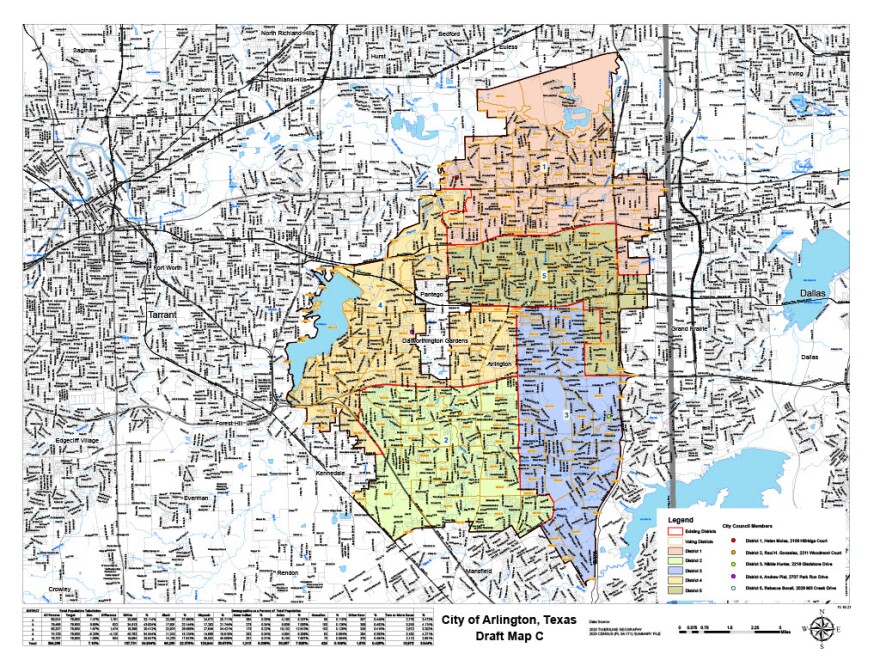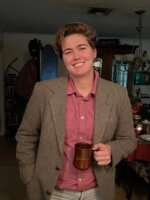Arlington city council approved redrawn voting districts this week that some civil and voting rights groups say do not reflect growth in Black, Hispanic and Latino communities.
Council members gave final approval Tuesday to a map that redraws four of the city’s five single-member districts to more evenly split Arlington residents. The city-appointed redistricting task force selected the map as the best of five put forward — three from , two from residents and community groups.
The approved map moves voters in the area between North Bowen Road, West Sanford Street, Oakwood Lane, and West Randol Mill Road/Westwood Drive from District 1 to District 4. District 3 residents in the boundaries of East Arkansas Lane, New York Avenue, Sherry Street, and East Mayfield Road will become part of District 5. The maps give slightly more voting power to Hispanic and Latino voters in District 1 and to Black and African-American voters in districts 3 and 5.
The 7-1 vote was the last needed to finalize the new districts ahead of municipal elections in 2022 when residents will decide four city council seats. Ruby Faye Woolridge, at-large District 6 council member, voted against the map.
Woolridge applauded the redistricting task force’s efforts and formation; the group marks the first time a community board formally advised city council during the redistricting process.
“I’m very grateful for that and I look forward to the future and the progress that will continue to be made,” she said.
Mayor Jim Ross was absent from the meeting.
The final vote followed months of criticism from local NAACP and LULAC chapters, whose leaders claimed the redistricting task force and council upheld districts that dilute voices in communities of color.
“Same old, same old”
Luis Castillo, president of , said the city has historically protected incumbents who, until recent years, have been mostly white. Castillo argued the same interests caused the city to gravitate from eight at-large council members to five single-member districts and three at-large members.
“It’s a continuation of the same old, same old,” he said.
Castillo’s group and Arlington NAACP submitted a map that stretched District 4, a majority-white voting district, to cover northwest Arlington, including Viridian, the city’s master-planned community composed of upscale housing developments. The leaders have opposed the task force-recommended map, and defended their submission, drawn in a manner that would give communities of color more voting power in the city’s northern, southeast and eastern regions — districts 1, 3 and 5, respectively.
Alisa Simmons, Arlington NAACP president, told council members Dec. 7 the city’s 8% population growth between 2010 and 2020 was “entirely driven by Arlington’s communities of color.” The 2020 census put, making it the .
“When combined, these groups can together constitute a majority of the city’s voting age population in possibly three districts,” she said.
Attorney Rezzin Pullum with Bojorquez Law Firm told council the same day the groups’ map did not fall in line with two city-instituted requirements for redistricting: that the new lines do not alter district shape as much as possible or draw sitting council members out of their districts. The NAACP and LULAC map would have cast District 1 Council Member Helen Moise into District 4, a majority-white district.
Stephanie Swanson with the League of Women Voters of Texas
said the NAACP and LULAC map did a better job of upholding t, which prohibits practices that discriminate against race, color or languages spoken by voters.
“Preserving incumbency is a very problematic redistricting criteria to adopt,” Swanson said. “There is no federal law stating that incumbents must be protected.”
Bojorquez Law Firm reviewed the concerns Swanson and the groups raised during redistricting and did not find issues that would open the city to legal action, city staff said.
Incumbents' power diminished?
Moise said the term limits for mayor and council seats that voters approved in 2018 temper concerns that incumbents can leverage redrawn lines. Moise can run for one more council term under limits that confine candidates to 12 years in office, or three two-year terms holding any council seat or serving as mayor.
In her first two races, Moise said, she ran against Black or African-American candidates, and she won support from communities of color for her work to support neighborhoods. Moise was first elected in May 2018 and re-elected in November 2020.
“I love District 1; I’ve lived in it for 38 years,” she said. “In both of my elections, I ran a campaign that said I would serve every single person in my district, and my district listened."
Moise’s seat is one of four voters will decide in 2022, when the new districts go into effect. Raul Gonzalez, who represents southwest Arlington in District 2, for re-election. Arlington voters will select two new at-large council members, as Victoria Farrar-Myers, District 7, is being termed out, and for Tarrant County commissioner’s court.
Got a tip? Email Kailey Broussard at kbroussard@kera.org. You can follow Kailey on Twitter .
�Ļ�ӰԺ is made possible through the generosity of our members. If you find this reporting valuable, consider . Thank you.





